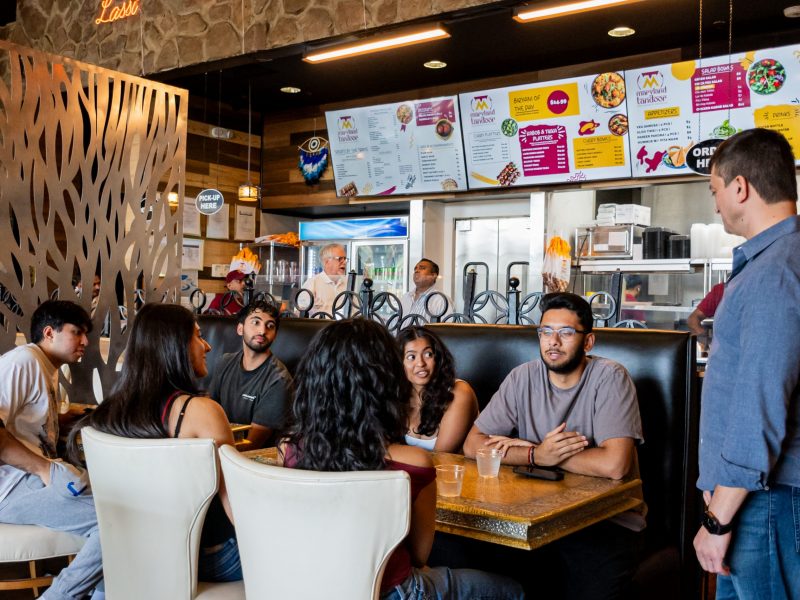When Dining Services and Office of Sustainability officials teamed up last year to swap plastic foam products used in several dining locations around the campus for an eco-friendly, compostable alternative, they envisioned the change would propel university sustainability initiatives forward.
But that’s not exactly what happened.
Dining halls now use carry-out containers made with bagasse, a waste-product of sugarcane that is 100 percent compostable. Dining Services switched products because plastic foam does not recycle well, Assistant Director of Dining Services Bart Hipple said.
But students said they don’t know how or where to compost the bagasse containers, and officials said they had trouble finding an efficient method of converting them into a suitable composted product.
The university’s composting activity decreased substantially from 2008 to 2009, according to the most recent Sustainability Report. Hipple said the decline occurred because the company that was supposed to pick up the material was unreliable, forcing Dining Services to throw otherwise compostable products in the trash.
But Hipple said they have since hired a new company to haul food waste, bagasse containers, drink cups and compostable soup bowls to a processing center on the Eastern Shore.
But of the 40,000 bagasse containers used on the campus per week, Hipple said it is hard to know how many are actually being composted.
“I would hope that they’re all being composted, but I’m not sure enough to guarantee that,” Hipple said. “Our staff is trained to know what is supposed to be composted and what is not, so hopefully they are composting them, too.”
But Dining Services’ efforts may be falling on deaf ears. Many students said they barely notice the extra charge for take-out containers, and despite marked composting bins designated for bagasse containers inside the Dining Hall on North Campus, many said they weren’t aware the containers were meant to be disposed of differently.
“I think that if the to-go boxes are compostable, it should be labeled, or at least written somewhere for students to know,” Sara Sousa, a sophomore cell biology and genetics major said. “I feel like if I had known, I would definitely toss them out in the appropriate bins. Every time I take a to-go box, I simply throw it in the regular garbage.”
Erin Kersell, sophomore environmental science and policy major, agreed she would compost her containers if she knew how to do it correctly.
“I’m never sure what’s supposed to be composted, so I just don’t compost anything,” she said. “I don’t want to put the wrong things in the composting cans — I feel like that might do more damage.”
Officials, however, aren’t too concerned that many of these containers end up in garbage cans — Manager of the Office of Sustainability Mark Stewart said even if the bagasse containers aren’t composted, the paper-like product will break down no matter where it is, though the process takes longer in a landfill.
“With Styrofoam, it often gets blown around outside and ends up in bodies of water, like the Chesapeake Bay,” Stewart said. “One of our incentives for the switch was to find something biodegradable. Styrofoam sticks around for a long time. If bagasse ends up in the ecosystem, it will break down.”
Though bagasse is more expensive — roughly 24 cents per container versus six and a half cents per plastic foam container — the 25-cent take-out charge covers the expense and also acts as a reminder for students that they are making the less environmentally-friendly choice by boxing up their food, Hipple said.
Dining Services workers compost the containers left on the conveyor belt, and some students do seem to have gotten the message. Sophomore geology major Grant Jiang said he composts most of the bagasse containers he uses.
“I like being environmentally friendly and this is a small way of helping out,” Jiang said. “Every little bit counts.”
Hipple said Dining Services originally hoped to use a machine that would turn compostable waste material into a product used to enrich soil on the campus. But Dining Services piloted the program and found the machines couldn’t process the high quantities of waste generated by the large campus.
But shipping the materials to be composted at another site is more expensive, and officials still discourage students from using any to-go containers unless absolutely necessary.
“Our preference is that you use the reusable plates and cups,” Stewart said. “But if the take-out is your only option, then at least compost them.”
Hipple said officials plan to meet with the Student Government Association and the Residence Hall Association to brainstorm ways to raise composting awareness.
“It’s always a process,” he said. “We’re not satisfied. We don’t think we’re where we’d like to be, but we’re on the right path.”
“I would like to see the day when the university sends nothing to the landfill,” Stewart added, “and the scarce bit of compost we generate will only consist of non-edible organic waste.”
egan at umdbk dot com


